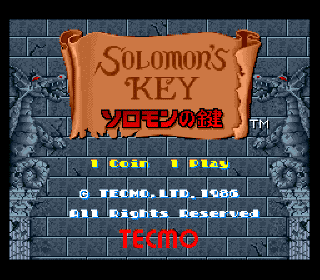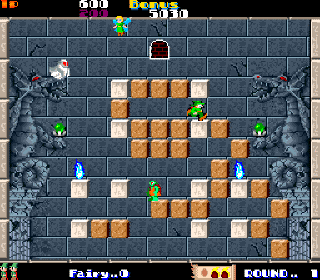 The gameplay is deceivingly simple: place and delete blocks that Dana uses to
move about the level. Deleting blocks directly underneath an enemy causes him to fall to
his death. Dana can also smite his enemies with fireballs, but he can only carry three at
a time, which must be collected one-by-one when found in various rooms.
The gameplay is deceivingly simple: place and delete blocks that Dana uses to
move about the level. Deleting blocks directly underneath an enemy causes him to fall to
his death. Dana can also smite his enemies with fireballs, but he can only carry three at
a time, which must be collected one-by-one when found in various rooms. Death of the
player can be brought about in a number of ways. Some enemies can spit fireballs or
breathe fire, and as in most games, simply touching an enemy will cause death. Each level
is timed, and Dana will be killed if the timer is allowed to reach zero. Various bits of
score-swelling treasure are strewn about in each level, and bells can be obtained which
cause the appearance of flying fairies. The collection of 10 fairies yields an extra life.
Spanning nearly 50 levels or "rooms", this game has the potential of eating up
quite a few quarters were someone to attempt to complete it. Subsequent ports of this game
were released on the Commodore 64, Sinclair ZX Spectrum, and most famously the Nintendo
Entertainment System. Solomon's Key 2 was released in Europe and Japan in 1992,
and was released as Fire
'N Ice in the U.S. the following year.
Solomon's Key offers a puzzle enthusiast a very engaging and addicting gameplay
experience. The game utilizes a joystick and two buttons. The joystick is used to maneuver
Dana around the room, with a jump being performed by pressing up. One button is used to
create and destroy blocks, while pressing the other caused Dana to use a fireball. The
controls are very responsive and do not feel in any way sluggish.
The game's graphics are quite colorful and detailed for it's time. Visually, the game has
a Super Nintendo-like feel to it, and a direct port of the game to that system would have
looked great. Although the same elements are used to create each room, some variety is
added by cycling through various backgrounds. An excellent comparison would be to the 1986
Taito release Bubble Bobble. Both were released during the same year, and are of
the same genre, but Solomon's Key is clearly superior visually. For it's time,
this title has exceptional graphics.
 The games sound is equally colorful. A catchy background track
plays during each room, and the game plays various little jingles when certain items are
obtained, when a room is cleared, and when Dana is killed. The sound effects are pretty
standard. The game has specific sounds for the creation and deletion of blocks, the usage
of fireballs, etc. Nothing really noteworthy, but nothing stands out as being poor,
either.
The games sound is equally colorful. A catchy background track
plays during each room, and the game plays various little jingles when certain items are
obtained, when a room is cleared, and when Dana is killed. The sound effects are pretty
standard. The game has specific sounds for the creation and deletion of blocks, the usage
of fireballs, etc. Nothing really noteworthy, but nothing stands out as being poor,
either.
Solomon's Key definitely offers up a challenging gaming experience. The
difficulty level is well balanced, starting easy and growing progressively harder. A
patient gamer will have a hard time getting frustrated, as with each death should come the
realization of what was done wrong and what can be done differently to avoid the same
mistake on subsequent attempts. The game is just challenging enough that the player will
feel motivated to keep trying to complete a problem level without throwing his or her
hands up in the air and walking away.
The gamer that chooses not to give Solomon's Key a try is really doing themselves
a disservice. For me, games like this are what being a gamer is all about. This game will
suck you in and you won't stop thinking about a particular level until you have solved it.
If you are interested in puzzle games with a bit of action mixed in, Solomon's Key
will scratch you right where you itch.